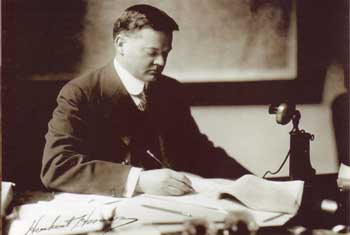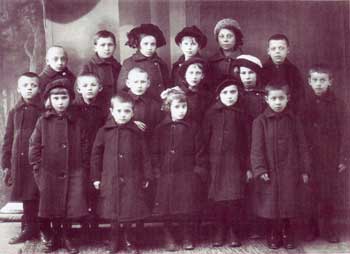Herbert Hoover and Poland

The 31st U.S. president, Herbert Hoover was born on August 10, 1874 in West Branch Iowa, a closely knit community with a strong religious identity. Many residents, like the Hoovers, were Quakers. Orphaned at the age of ten, Hoover was adopted by an uncle and relocated to Oregon where he attended Quaker schools and found a sense of belonging and a strong belief in the common good. At age seventeen, he was admitted to Stanford University. Having earned a degree in geology, he worked as a mining engineer around the world. The Australian Gold Rush and the Chinese Boxer Rebellion provided opportunities to apply his scientific knowledge, crisis management skills, and dedication to humanity.
In England, at the outbreak of WWI, August 1914, Hoover organized the Commission for Relief in Belgium (CRB). He directed the procurement, delivery, and distribution of food to Belgian civilians, then under German control.
In 1918 President Woodrow Wilson asked Hoover to head the non-governmental American Relief Administration (ARA). Grounded in the spirit of compassion, he ably organized a "peace army" that saved millions from starvation and disease in the nations of Europe and the Middle East following the war.

Children in coats and shoes delivered to Sambor in 1920
The ARA focused its efforts on famine-stricken Central Europe; and Hoover rapidly mobilized his peace army to aid Poland. Millions of Americans made personal sacrifices; and surplus food was shipped overseas. An orphan himself, he was sensitive to the suffering of children. By 1920 two million children were fed from ten thousand kitchens. A Quaker who valued people from all religious persuasions and ethnicities, Hoover set up 1500 feeding centers for Jewish children, aided by the Jewish Joint Distribution Committee. A talented facilitator, he connected services and resources of American Poles, the American Red Cross, and the American Friends Service Committee (AFSC) to the afflicted peoples of Poland, Finland, Czechoslovakia, Romania, Austria, and Serbia. This exhibition, while in Philadelphia, will include archival material from the AFSC.
In August 1919 during his visit to Poland, Hoover witnessed a heartbreaking scene in Warsaw: Twenty-five thousand children had walked barefoot to pay him homage. Within hours he telegraphed for help and 700,000 overcoats and 700,000 pairs of shoes were shipped to Poland before the onset of winter. Another half million coats and shoes were delivered in the following two years. The Russian invasion of 1920, which led to the occupation of half of Poland and the requisition of food and livestock by the invading armies, pushed Poland back to where it had been a year earlier. ARA work was extended in Poland and by 1922 half a billion meals were provided for her hungry and starving people.

Herbert Hoover surrounded by Polish war orphans. April 2, 1946
In 1939 Hitler invaded Poland and Hoover initiated the Commission for Polish Relief (CPR). Hoover raised funds and obtained cooperation from foreign governments, private charities, and health organizations. Within a few months the commission delivered 150 tons of clothing and blankets. In early 1940 CPR organized kitchens and served 200,000 meals a day. The commission's work was significantly helped by a $50 million donation from the American Red Cross that February. CPR continued to operate in occupied Poland until Germany declared war against the United States in December 1941. The commission then aided Polish refugees who fled their country.
Following the Allied victory, President Harry S. Truman asked Hoover to head the United Nations Relief and Rehabilitation Administration (UNRRA) in aid of countries suffering from the devastation of WWII. In early 1946 Hoover traveled to 25 countries. In his efforts to rebuild Poland, Hoover sought technical experts, medical supplies, construction equipment, and food. With the efficiency that Hoover was famous for, aid reached millions of people, especially children.
The welfare of children was a lifelong concern for Herbert Hoover. After WWII he helped establish two relief organizations: the United Nations Children's Fund (UNICEF) and Cooperative Assistance in Relief Everywhere (CARE).
Exhibition
Arch Street Friends (Quaker) Meeting House
320 Arch Street, Philadelphia
215-413 1804
Open Monday-Saturday, 10am-4pm
September 29, 2007 — March 15, 2008

This exhibition featured Hoover's decades of humanitarian achievements in Poland. It has woven photographs, documents, posters, and banners from the Hoover Institution Archives and the Polish National Archives, some being shown for the first time. Dr. Z. Stanczyk of the Hoover Institution of Stanford University comments, "From early childhood Hoover practiced compassion. His Quaker upbringing changed the world. Poland in this exhibit is just a case study of what Hoover did in dozens of other countries." Through these humanitarian endeavors Hoover inspired hope in millions of suffering people. That suffering and Hoover's efficient response resonate powerfully in our world today, with millions of refugees displaced by war and violence while victims of draught, flood, and other natural disasters across the globe find little relief.
Memories of Hoover and his achievements were officially erased in Poland after 1945. But when this exhibition opened at the Royal Castle in Warsaw, November 2004, it was welcomed with great outpourings of emotion. After touring four other cities in Poland and met with a similar reception, it returned to Stanford.
It was at Stanford University where Hoover met Ignacy Paderewski who in 1919 became the first prime minister of the Republic of Poland. In 1892, the impoverished geology student arranged a piano recital for the world-renowned musician. Unfortunately, Hoover was neither able to meet Paderewski's fee nor pay expenses. Paderewski generously covered the cost of the event and their enduring friendship inspired Hoover to understand the Polish people and their passion for independence. The two friends later worked together to save a people ravaged by war and foreign domination and to preserve Polish sovereignty.
Exhibition Sponsors
- Okreg 2 SWAP
- State Representative John Taylor
- The Kosciuszko Foundation, Philadelphia
- The Chace Grant of PYM
- Pro Arte Associates
- Philadelphia Yearly Meeting of the Religious Society of Friends (Quaker) -- Interpretation Program


